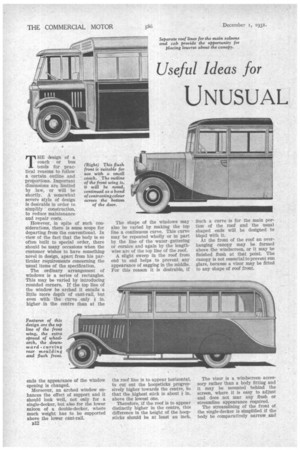Useful Ideas for
Page 46

Page 47

If you've noticed an error in this article please click here to report it so we can fix it.
UNUSUAL BODY DESIGN
Without Adding Greatly to the Cost Some Unusual and Artistic Effects Can be Obtained, Lending Distinction that Constitutes a Publicity Asset
T HE design of a coach or bus tends for practical reasons to follow a certain outline and proportions. Important dimensions are limited by law, or will be shortly. A somewhat severe style of design is desirable in order to simplify construction, to reduce maintenance and repair costs.
However, in spite of such considerations, there is some scope for departing from the conventional. In view of the fact that the body is so often built to special order, there should be many occasions when the customer wishes to have something novel in design, apart from his particular requirements concerning the usual items of the specification.
The ordinary arrangement of windows is a series of rectangles. This may be varied by introducing rounded corners. If the top line of the window be arched it entails a little more depth of cant-rail, but even with the curve only in. higher in the centre than at the ends the appearance of the window opening is changed.
Moreover, an arched window enhances the effect of support and it should look well, not only for a single-decker, but also for the lower saloon of a double-decker, where much weight has to be supported above the lower cant-rail.
B12 The shape of the windows may also be varied by making the top line a continuous curve. This curve may be repeated wholly or in part by the line of the water guttering or cornice and again by the lengthwise arc of the top line of the roof.
A slight sweep in the roof from end to end helps to prevent any appearance of sagging in the middle. For this reason it is desirable, if the roof line is to appear horizontal, to cut out the hoopsticks progressively higher towards the centre, so that the highest stick is about in. above the lowest one.
Therefore, if the roof is to appear distinctly higher in the centre, this difference in the height of the hoopsticks should be at least an inch. Such a curve is for the main portion of the roof and the usual shaped ends will be designed to ble,nd with it. At the front of the roof an overhanging canopy may be formed above the windscreen, or it may be finished flush at that point. The canopy is not essential to prevent sun glare, because a vizor may be fitted to any shape of roof front.
The vizor is a windscreen accessory rather than a body fitting and it may be mounted behind the screen, where it is easy to adjust and does not mar any flush or streamline appearance required.
The streamlining of the front of the single-decker is simplified if the body be comparatively narrow and the windscreen forms the front of the body without any triangular window between it and the door.
If an unconventional display of moulding is to be attempted it will probably be independent of the usual arrangement of framework. No radical alteration of the construction is necessary, but one or two rails ipay have to be added in order to . provide a foundation for fixing the moulding.
Alternatively, the moulding may be dispensed with, in which case the areas of colour concerned are separated by broad or fine lines painted on the panels.
A moulding having a returncurved outline may be placed across the rear of the main panelling. Starting from a• horizontal waistline moulding it sweeps downwards to the bottom and back of the body. This curve may be a repetition on a larger scale of the front-wing outline and the effect will be heightened if the rear wheel be paddleboxed, so that there is no back wing to set up a disturbing influence.
The moulding described above
may be repeated across the back of the body. If so, a loop is formed, this running from the last side window to the centre. of the back one.
A variation of this display of moulding may be obtained by employing a simple, instead of a return, curve. As in the first instance, it starts from the waist line and finishes at the bottoui, where the rounded rear corner begins: This style of moulding harmonises well with a domed-top back panel and the usual rear turnunder. • If the lower belt moulding forms a continuation of the top of the side of the bonnet, the whole of the area, as represented by the bonnet and the side of the body up to the new moulding line, may be painted in one colour.
A contrasting colour is used for the remaining portion of the body and roof, with or without a special shade for the belt. panel and top of the bonnet.
When extra mouldings are used they should consist of large curves in keeping with the area of panelling, the display being tasteful.
























































































